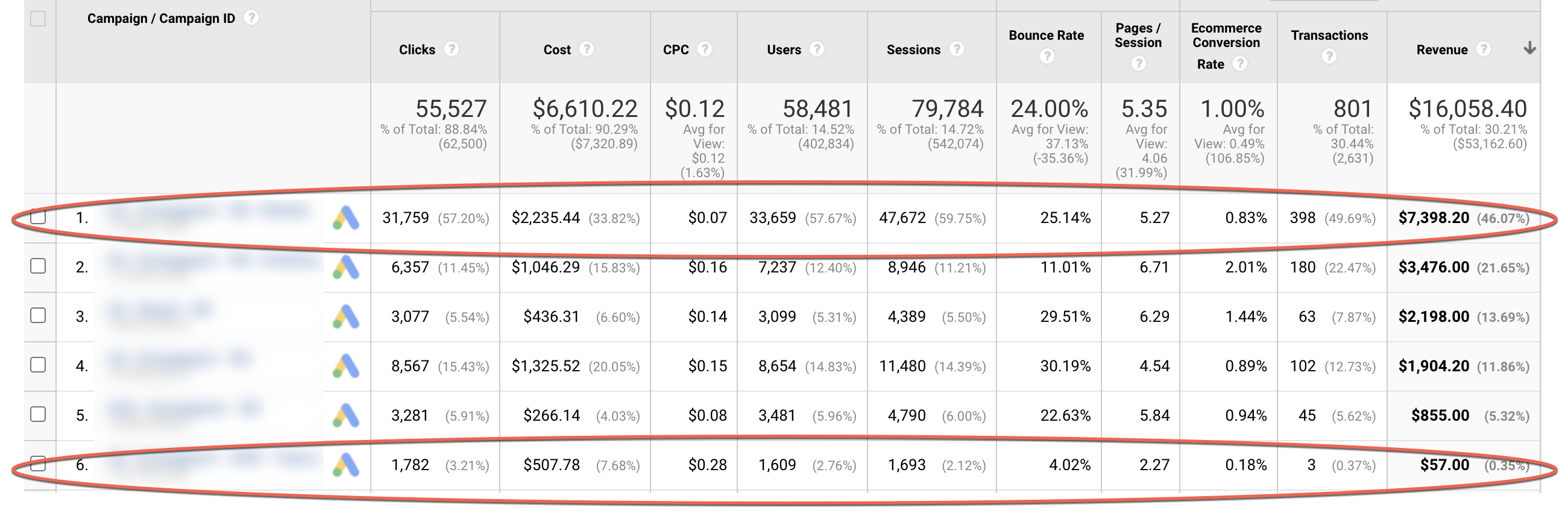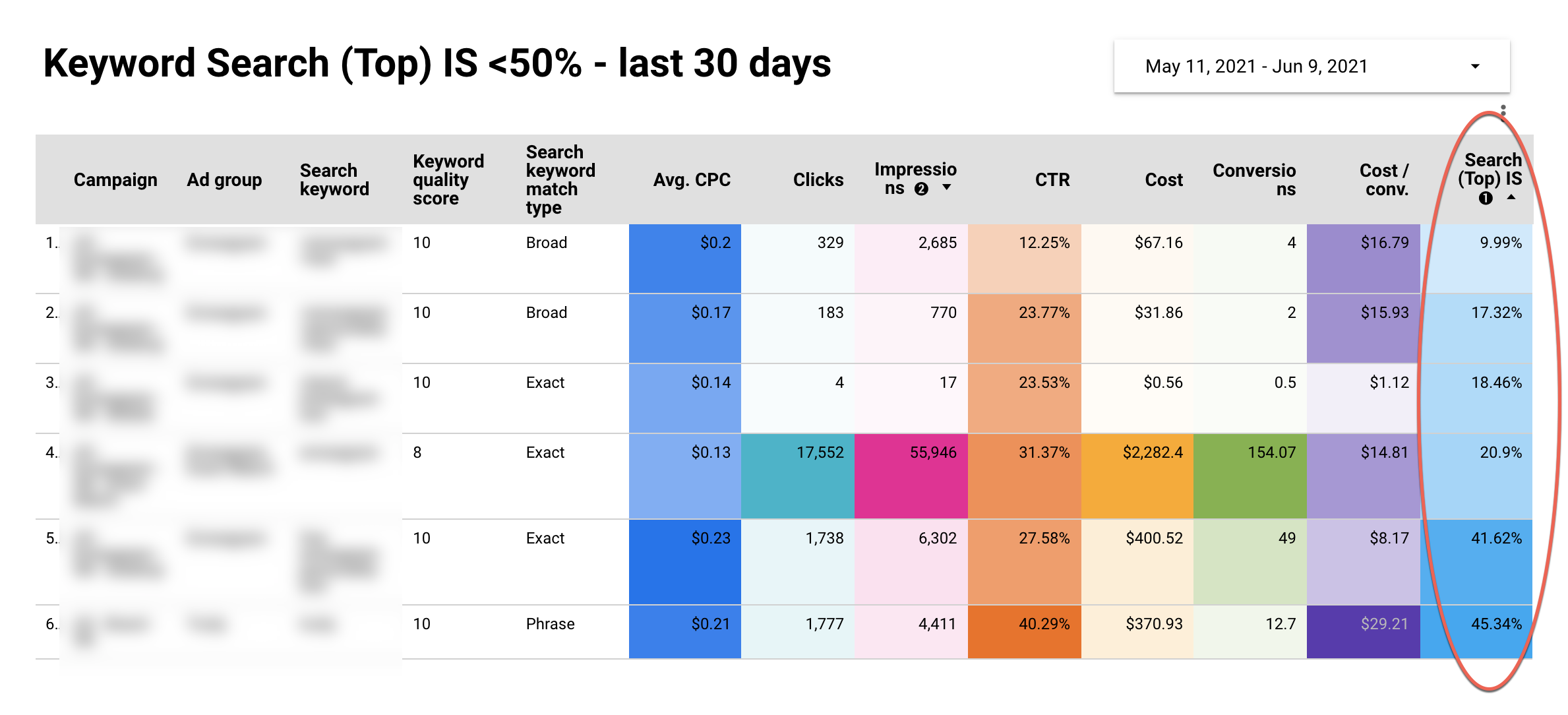Here’s a common scenario: You create several Google Ads campaigns for a product or service.
Some of those campaigns are really doing well.
Others… not so much.
So the logical thing to do is pause the underperforming campaigns and divert that budget to the ones that are doing well – right?
That approach might seem logical. But eventually, you’ll find that this approach is a dead end.
In this article, you’ll discover the dangers of routinely pausing underperforming Google Ads campaigns and sinking all of your budget into top performers alone. You’ll learn what to do instead, too, to better support your campaigns and grow your account.
The Challenges of Marketing a Diverse Product Mix
We have a client who sells two main products.
The primary product generates the vast majority of the company’s revenue.
The secondary product generates only a small portion in comparison.
This inequity within this product mix is also reflected in the company’s Google Ads campaigns.
Advertisement
Continue Reading Below
Campaigns for the top-selling primary product garner a stellar four-times return on investment.
Meanwhile, ROI for the secondary product is paltry in comparison.
Naturally, it’s super tempting to keep the campaigns for the hot seller going and stop the campaigns for the underperformer.
But where would that ultimately get us?
Let’s dig into this question by comparing results for two campaigns (circled in red):

The campaign circled at the top is for the primary product. It earned $7,398.20 in revenue.
Advertisement
Continue Reading Below
In contrast, the campaign for the secondary product (circled at the bottom) is not doing nearly as well, earning only $57.00 in revenue!
With such a dramatic difference, is it any wonder the kneejerk reaction is to pause the underperformer and double down on the top performer?
But that’s not what we did. Instead, we aimed for middle ground.
Rather than set an overall ROI PPC goal for the account of 4X (which we could have easily accomplished by going all-in on the top performer), we set an overall goal of 2X.
We did this knowing that the top performer would buttress the results of the lower performer.
Why did we do this? (And why on earth did the client agree to it?)
Because relying on only one product is risky.
After all, isn’t that why people develop a product mix in the first place? It’s a way to introduce diversity to reduce risk and facilitate future sales and growth.
The same logic applies to PPC campaigns. If we only put budget behind the top-performing campaigns for the top-performing product, brand awareness for the secondary product will never grow.
In this case, the risk was even higher because the campaigns for the primary product also relied on one keyword to drive most of the sales.
Here’s another way to look at it: You’ll always have underperformers in your PPC program. If you pause them as a matter of course, you’ll eventually end up with nothing left to optimize!
Thankfully, our client agreed with our logic, recognizing the need to think longer-term and build more awareness around their secondary product.
Optimize Google Ads Campaigns Instead of Pausing
This may all sound good in theory. But if you’re not pausing underperformers, what should you do instead?
The alternative is to take a more holistic, long-term approach with your PPC strategy.
Here’s how we proceeded for this client in this situation:
Advertisement
Continue Reading Below
1. Conduct a Competitive Review
Sales had been gangbusters for this client’s primary product for a while, so we had the competitive landscape well scoped out.
But we didn’t have the same knowledge and understanding of the competitive landscape for the client’s secondary product.
We conducted a competitive review for this product, which proved vastly helpful.
We learned a lot by looking at the offers, messaging, and site experience of competitors, which prompted a redesign of a few elements on the client’s website and a second look at our messaging strategy.
By the way, this competitive analysis also proved valuable to the client not just for the purposes of PPC. Some of our findings took the client by surprise, and they’ll be using them to improve their business more generally.
2. Update Landing Pages
When campaigns are underperforming, it’s always a good idea to take a closer look at landing pages.
Unfortunately, pre-click activities such as ad messaging, ad formats, and targeting tend to get all the attention. Post-click elements such as landing pages are often overlooked — but they’re just as important!
Advertisement
Continue Reading Below
We soon discovered that the landing pages for the client’s secondary product were outdated.
So we did a revamp, leaning into the user journey and personas to guide the messaging and call to action as well as adding trust signals.
3. Conduct an Optimization Audit
Next, we audited the account using Data Studio and found some great optimization opportunities with budget, keywords, and strategy.
Budget Strategy
In the process of our audit, we noticed a few keywords in our underperforming campaigns had a low impression share:

As you can see in the last column (circled in red), the top row keyword was only getting impressions 9.99% of the time, which is much lower than we like to see.
Advertisement
Continue Reading Below
We think this is happening because the client’s secondary product has more competition on the SERPs.
So we started testing different budget strategies to see if we could drive this number up.
Keyword Strategy
Next, we went back to the basics with our keyword strategy.
Our competitor review uncovered quite a few new keyword options we hadn’t considered before, so we started testing them.
Consequently, we found some great long-tail search query terms we’d never tried before that are delivering promising results.
Campaign Strategy
Finally, because the secondary product is a harder sell, expecting a single search text ad to drive a sale was unreasonable.
Thus, we revisited the overall budget and dedicated a portion to GDN and video ads to drive brand awareness that will pay off down the road.
We also updated our messaging to better tailor it to our audience based on the findings of our competitive research.
Don’t Pause Your Google Ads Campaigns, Reassess Them
While it would be great (in theory) if all your campaigns were top performers all the time, that just doesn’t happen.
Advertisement
Continue Reading Below
Some campaigns will always be more successful than others, especially if you’re trying to expand your product mix.
So when you have less-than-stellar performers, don’t hit “pause” too fast.
Instead, look for ways to improve their performance.
And cut them some slack – even if they continue to underperform relative to your top-performing product.
Because in the long-term, it’s the underperformer that might make all the difference to your business.
More Resources:
Image Credits
Featured image: Dreamstime.com
Screenshots taken by author, June 2021
 seolounge
seolounge